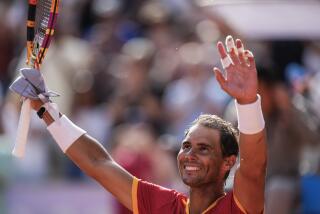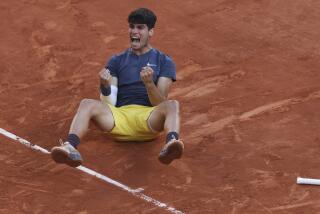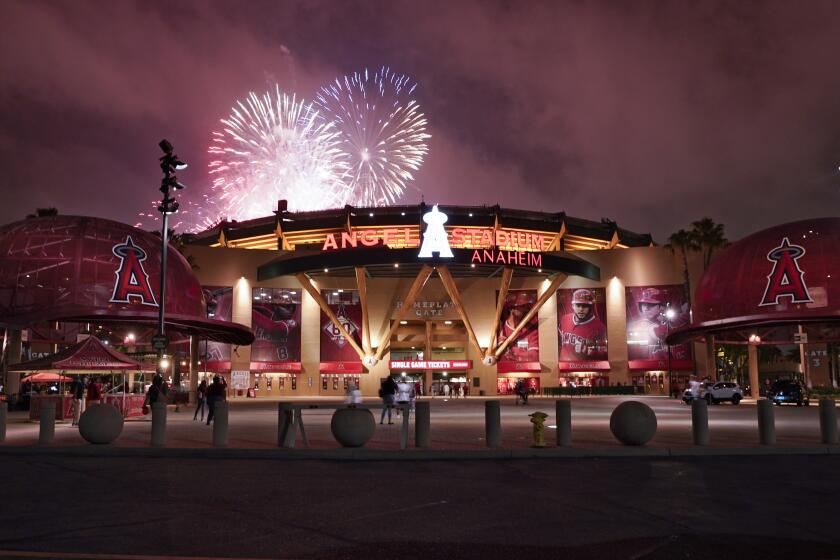Roger Federer concedes nothing, to opponents or to age
- Share via
It is not merely the laws of tennis that Roger Federer is defying. It is the laws of nature, of logic, of aging and human endurance.
He is 30 years old and is amused when that is even brought up. They make movies about bionic men. Federer should star in the next one.
When he beat John Isner in Sunday’s BNP Paribas Open final, it wasn’t so much that he won, but that his winning appears to foreshadow more of the same. And that it continues on a level of tennis that demands a near-perfect body more than a near-perfect forehand.
The score Sunday was 7-6 (7), 6-3. Isner is 6 feet 9, is just starting to make a breakthrough, and even he understands the rigors of the game he plays for a living. He is 26, but says he is one of the lucky ones, because he went to college, got his degree from the University of Georgia and was spared the wear and tear of those years on his body that would have been inflicted by the pro tour.
Pro tennis is played mostly on hard courts now. It has standardized the game for promoters and shortened careers for players. The years of many matches on grass and clay, softer and more forgiving surfaces, are gone. Three of the four Grand Slam events — the Australian Open, Wimbledon and the U.S. Open — were once played on grass. Now, only Wimbledon and the French Open (red clay) are still contested on their traditional surfaces; the other two are hard-court tournaments.
Rafael Nadal is among the best ever to play the game. With 10 major titles, some project him to pass Federer’s record 16. He will be 26 in June and won his 10th major last year at his favorite, the French, which he has won six times. But what appeared to be an unstoppable run a few years ago has been slowed by injuries — mostly sore knees — and Nadal went on an uncharacteristic tangent in a news conference after one of his matches here the other day, citing the need for tennis to understand how hard courts were breaking down all the players.
If he had thought that through, he would have amended it to “breaking down all the players, except Federer.”
Federer has been a regular on the pro tour since 1999. Earlier this year, he passed the 1,000 mark in tour matches played. You can count on one hand the number of injuries he has had, at least those he’s publicly acknowledged.
As he did against Isner on Sunday, and as he has throughout his career, Federer seems to float when others run. He gets to the ball without noticeable effort, and he hits it the same way. His demeanor is similar — unruffled, in control and stunned that anyone would perceive otherwise.
Isner had him right where any self-respecting big server would want him in the first-set tiebreaker. He had a 3-2 lead and four service chances ahead. The math is simple. Convert all four and you win the tiebreaker. The math should have been equally simple across the net, but it probably never occurred to Federer. He knew, as did just about everyone in the packed stadium — capacity 16,100, but they actually let in 16,668 Sunday — that Federer would figure something out.
At 7-7 point on Isner’s serve, Federer hit a half-lob, half-passing shot that somehow got over the head of the 6-9 Isner and dropped like a sack of potatoes onto the baseline.
Isner called it “that backhand pass lob, whatever it was.”
That gave Federer his fourth set point, which he converted on his serve, and Isner had learned the lesson: If it is a crucial time and Federer hits the shot, it will go in.
Along about the time Federer lost in an agonizing semifinal at last year’s U.S. Open to Novak Djokovic, holding two match points and a 2-0 sets lead, many who type on computers and babble into microphones for a living began to theorize what appeared obvious: Federer’s career is in the twilight. Let’s show respect and celebrate the old guy as he hits a few more overheads before settling in next to a fireplace in a ski lodge in Switzerland.
But wait. It appears that rumors of Federer’s demise are premature.
Since that U.S. Open semifinal, Federer has won 39 of 41 matches. He’s 22-2 this year, the losses to Nadal in the Australian semifinals in January and to Isner in a Davis Cup match in February. Saturday in the semifinals, he avenged the Nadal loss. Sunday, he did the same with Isner.
Federer certainly understands the dynamics of being Roger Federer much better than the typists and babblers. He addresses his injury history by saying he has been mostly lucky. He says being No. 1 is not high on his list of goals now —- even though he is No. 3 and was the top guy for five of six years, starting in 2004 — because Djokovic is so good and so entrenched. He says he understands what is written and said about him being in decline.
“It’s the age that people talk about right now,” he said Sunday. “Some don’t understand how you can play tennis at 30, which is shocking to me.”
It’s not shocking to all the players in the trainer’s room, with ice on their knees.
In a ceremony after his win, Federer collected a check for $1 million and a trophy representing his record fourth Indian Wells title.
He told the crowd he’d be back. The 16,668, part of another record tournament attendance of 370,406, cheered that, even though, it is clear now, there was never a doubt.
Roger Federer, the amazing man from Switzerland, has much magic left. It is only a matter of where and when the next rabbit comes out of the hat.
More to Read
Go beyond the scoreboard
Get the latest on L.A.'s teams in the daily Sports Report newsletter.
You may occasionally receive promotional content from the Los Angeles Times.











